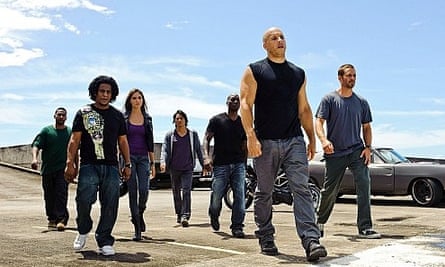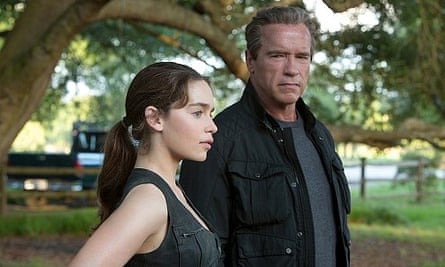Forty-five minutes into the seventh Fast & Furious movie, Vin Diesel drives towards a huge precipice. The audience have only the faintest idea why he’s there. Ditto why they have paraglided their cars into Azerbaijan. Is it Azerbaijan? It’s probably to rescue someone … who was it again? Something to do with a surveillance gizmo means they need to find their nemesis Jason Statham, except Statham seems to find them whenever he wants, being the one about to push Diesel off the cliff, not the random mercenaries they’re nicking the device from. Only Kurt Russell – who’s watching everything from his covert-ops unit and chatting about craft ale – seems to understand what the hell is going on.
What was once a series content to celebrate simple boy-racer pleasures, the seventh Fast & Furious fell prey to a recent tentpole-film affliction: ridiculously over-complicated plotting. Iron Man 3 and Mission: Impossible – Rogue Nation writer Drew Pearce draws an analogy for this blockbuster bloat, responsible for routinely pushing run times over the two-hour mark: “Much as I love a prog-rock album, if it’s a pop song I like it to be short and sweet, and I think it has more impact that way. And summer blockbusters are very proggy right now.”

This byzantine plot sprawl has been in full effect this year. Avengers: Age of Ultron lost many round about the point the villain heads off to a South African shipyard in search of something called Wakandan vibranium. Promoting the film, writer-director Joss Whedon acknowledged that keeping all the narrative plates spinning for his six-man superhero team, plus all the side players, had left him “a little bit broken”. Terminator Genisys director Alan Taylor, faced with the collective “eh?” over his recent convoluted overhaul of the Schwarzenegger classic, made a spirited attempt in interviews to break down the film’s supposed seven interweaving timelines. But if his film had worked, he wouldn’t have needed to.
Pacific Rim screenwriter Travis Beacham says he first noticed this “pet peeve” with the advent of the Marvel films: “It’s a very literal complexity, it’s not an emotional complexity. It’s very point A to point B, we have to get the talisman to stop Dr Whatever from raising an army. Very pragmatic stuff that doesn’t leave a lot of room for character.” He compares Jurassic World to the original Jurassic Park: “In the first film, there’s only a handful of major sequences: the T-rex attack in the rain, the velociraptors in the kitchen. But because there are so few, you can really spend some time with them, and let them unfold. The latest one is this wall-to-wall sequence of events, and there’s not a lot of suspense.”
What happened to the industry in the intervening 20 years? In the rush to give restless, spoilt-for-choice modern viewers value for money, the studios are making their blockbusters in an ever more feverish climate. The past decade has seen, in the struggle for prime spots on the movie-going calendar, the rise of release dates locked in years in advance. In order to hit those targets, production schedules have little room for deviation; finished scripts often lag behind the key special-effects sequences, which are devised early so mockups around which actors can be directed are ready when shooting starts. Screenwriters, says Pearce, are often left to link the showpieces as best as they can.
“Because of that, you get these kind of labyrinthine machinations to desperately weave in character motivation, geography and the practical aspects of getting from one scene to another.”
“People are so in the white-hot crucible of terror of making the movie,” he continues, “It’s very difficult for them to take a step back and look at the story at a macro level.” This often results in a storyline that’s hectoring but lacking in any emotional through-line; the kind of rickety plot-slalom that in the case of the interminable Transformers films, batters the viewer into a state of “weird, robot-based PTSD”.
Then there’s the added burden of clumsy exposition needed to make the thing work, often introduced at the behest of the studio executives.
“It is an industry that at its higher levels is motivated by fear,” says Beacham, “And often before there’s a reason to be afraid ... In my experience, very few people walk out of a movie. You have them for two hours, and you’re free to explain or not explain whatever you see fit.”
Another major culprit in contorting and convoluting blockbuster plots is the need to service the overarching franchises that now rule the business. Not only is squeezing the likes of the voluminous Marvel and DC mythology into two-hour chunks a serious logistical challenge, but the reverence for branded IP (intellectual property) over original pitches has shifted the balance of power in the scripting process further from those most equipped to lead it.
“You have a lot of non-creative, business types leading the charge,” says Beacham, “because they’re the ones who control the IP. They have ownership of the thing everyone wants, and everyone’s coming to them to try to get that job. It ends up taking a lot of the creative leverage out of the hands of creative people.”
The current decree for the jobbing screenwriter is fitting franchise movies into the universes of inter-connected movies springing up left, right and centre. The old 80s and 90s “high-concept” simplicity that helpfully corralled the limits of an isolated story (“The bus blows up if it drops below 50mph”) has been shoved to the sidelines. Sequels and spin-offs have been proliferating for 15 years now, but what Marvel has set in motion – its superheroes making soapy cameos in each other’s works, The Avengers functioning as hub films for the whole circus – is a new level of integration. Warner Bros and DC are following suit with Batman v Superman and Suicide Squad, and Star Wars: The Force Awakens will float out Disney’s own Death Star of IP into this arena.

This thicket of story sprouting out of these universes can be “harmful to your movie’s point of view,” says Pearce, “when those stories overwhelm the central one, or take up so much real estate in the running time that your story is choked out by the weeds”. He and director/co-writer Shane Black were watching rough cuts of the first Avengers as they were writing Iron Man 3 and were determined to make any linkages meaningful. “We took a step back and said: OK, if Tony Stark were a real character, the events [in which he passes through a wormhole into an alien dimension] at the end of the Avengers are enormous and beyond the ken of a normal person. And we realised that by exploring a kind of PTSD about events, we could make his existential crisis richer.”
This is the ideal scenario, in which storytellers strive for enriching complexity. But such attempts can pull against the limits of the blockbuster form. Jonathan and Christopher Nolan’s screenplay for The Dark Knight is a model of discipline in its attempt to infuse a pulp format with heavyweight contemporary concerns and real-world nuance. The third film, though, struggles for the same exhilarating concision, particularly in its deployment of Bane and Catwoman as some sort of confused analogy for the Occupy movements. “It’s pulling so many ideas along,” says Pearce, “Don’t get me wrong, aspiration is a big part of it, but sometimes it is detrimental to the efficiency and entertainment of the final piece of art.”
Still, at least the Nolans play by the rules, unlike whoever greenlighted Hollywood’s most insidious recent innovation: the alternate timeline. The rebooted Star Trek franchise – which takes place in an alternative reality to the original Shatner iteration, triggered by a Romulan vessel travelling back in time and killing Captain Kirk’s father – has handled the idea relatively gracefully. But, in the wrong hands, as in Terminator Genisys, it becomes a carte blanche for Hollywood to over-embroider stories already told succinctly, or erase them at will, usually when there’s a commercial incentive. The more it happens, the more Hollywood saps its own sense of dramatic finality. One trend Beacham has noticed is that it is rare for any character to die, just in case they are needed in future; Gemma Arterton’s character, Io, was destined for the chop in the first-pass draft he did of Clash of the Titans, but in the final version Zeus handily resurrects her. And even if they do irreversibly shuffle off, like Darth Vader, there’s always the prequel.

But Hollywood’s growing problem with story density may just be the natural progression of most art forms towards baroqueness – and perhaps a purge is just round the corner. Star Wars: The Force Awakens screenwriter Lawrence Kasdan, a veteran classicist practitioner, recently criticised the bloated brigade and promised he and director JJ Abrams would bring in the new film, like the old ones, close to two hours: “When it’s over you’ll say, ‘I wish there’s more.’ Or, ‘Wait, is it over?’ Because how rarely you get that feeling nowadays.” Pearce praises the recent Mad Max, also a franchise film, for its spare arc; the simple forth-and-back boomerang of Tom Hardy and Charlize Theron’s desert trek opening up plenty of room for “weirdness and tonal zigzags”.
Beacham, whose Pacific Rim had a refreshing idiosyncrasy, is even more optimistic. “A lot of my friends are very cynical about this trend in blockbusters: it’s the new normal. But it’s a bubble, a temporary trend. Increasingly they’re not going to be able to compete with the ones that don’t conform to the easy way, with the ones that do it right.” Good triumphs over evil; now that’s easy enough to follow.

Comments (…)
Sign in or create your Guardian account to join the discussion